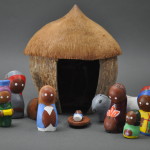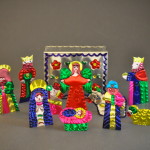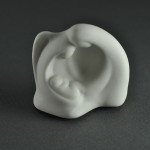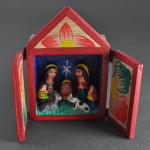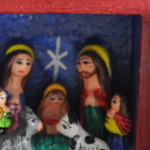This charming Nativity has 14 figures that are made out of clay and hand-painted. Several towns people were added to the usual figures that populate the Nativity . The stable is made out of a real coconut shell.
Tag Archives: miniature
Small Tin Nativity
This very colorful nativity is made out of hojalatas, or handworked tin. All figures are cut, punched, etched, and painted by hand. This kind of tin-work is a specialty craft of Oaxaca, in Southern Mexico.
The 10 figures which comprise this nativity are stored in a colorful punched tin box.
Adobe Hut Nativity
This miniature nativity is set in an adobe hut with a removable roof. The five clay figurines are no taller than 0.5 inches. The hut itself is 3.25” wide.
Embracing Holy Family
This sweet semi-abstract miniature holy family is carved out of stone.
Nativity Retablo
This Peruvian Retablo exemplifies the merger of Spanish Catholicism and Indigenous customs. After converting to Christianity Peruvians embraced the Spanish custom of creating portable shrines or retablos which were used for domestic devotions. These retablos were dedicated to saints or they depicted moments in the life of Jesus. The representation is often rendered in indeginous artistic idioms.
Brazilian Presépio
This playful Brazilian presépio or nativity has 19 painted clay pieces: Joseph, Mary, Jesus in a manger, a stable with silver star, a cactus, an angel, a shepherd, three kings, a donkey, a cow, a donkey, four sheep, a rooster and the plate on which this nativity is exhibited.
Two pieces are of note: the cactus and the rooster. The rooster refers to the legend that a rooster was present in the stable where Jesus was born. Immediately after Jesus’ birth the rooster started to crow, thus announcing the divine birth to the world. The Midnight Mass on Christmas Eve is known as the “Mass of the Rooster” in Brasil and certain other countries such as Spain and Bolivia. One cannot but make an additional connection with the rooster that crowed three times as Peter Denied Jesus. The cactus is a great example of inculturation. As each culture started to depict the nativity they added elements borrowed from their own experience. Whereas Germans and Austrians might add evergreens, people from more arid climates added a cactus.



